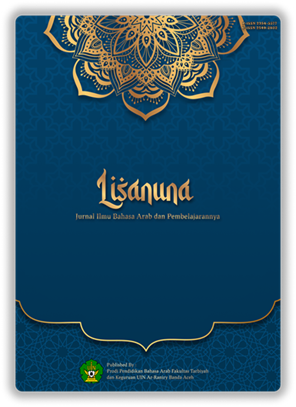Hubungan Penguasaan Sintaksis dan Morfologi Arab Terhadap Pemahaman Isi Teks-Teks Arab dalam Kitab Klasik di Pondok Pesantren Al-Mukhlisin Batu, Malang
DOI:
https://doi.org/10.22373/ls.v13i1.18034Keywords:
Syntax, Morphology, Mastery of Arabic TextAbstract
The aim of this research was to find out how the mastery of Arabic syntax and morphology relates to students' understanding of the contents of Arabic texts in the book at Al-Mukhlisin Islamic Boarding School, Batu City. This research is included in quantitative research because it uses statistical technique in the process of data analysis. The data collection for this research used a test instrument that was given to 25 students who were taken as a sample. Data analysis was performed using correlation to the collected data. The data consists of the independent variable, namely the mastery of Arabic syntax and morphology, and the dependent variable, namely the students' understanding of the contents of Arabic texts in the book at the Al-Mukhlisin Islamic boarding school in Batu City. The results of this study indicate that mastery of Arabic syntax and morphology has an influence of 86.4% on the ability to understand the contents of Arabic texts. The other 13.6% is influenced by other factors not discussed in this study, which are estimated to be in the form of vocabulary mastery, motivation, learning methods and models carried out in Islamic boarding schools, as well as other factors. In addition, the data stated that there was a strong correlation because it was known that p = 0.000 < 0.05 and the correlation coefficient value was 0.876.
Downloads
References
Abu Bakar Jabir Al-Jazairi, Mukhtasar Nahwu Al-Wadih (Beirut: Darl al-Kutub al-’Ilmiyah, 2008).
Abu Syuqqah, ‘Pengantar Ilmu Shorof.’, Jurnal Ilmu Al-Qur’an Dan Tafsir, 4 (2003), 67–81.
Afiana, Rika, Wienike Dinar Pratiwi, and Een Nur Hasanah, ‘Keefektifan Metode SQ3R Dalam Pembelajaran Mebaca Pemahaman Teks Fiksi Di Masa Pandemi Covid-19 Pada Siswa SMP’, Edukatif : Jurnal Ilmu Pendidikan, 3 (2021), 17–28.
Ali bin Abdullah As-Sanhuri, Syarhu Al-Jurumiyah Fi ’ilm Al-’Arabiyyah (Jakarta: Darus Salam, 2006).
Azyumardi Azra, Pendidikan Islam:Tradisi Dan Modernisasi Menuju Milenium Baru (Jakarta: Logos Wacana ILmu, 1999).
Burhan Nurgiyantoro, ‘Urgensi Bahasa Arab Dalam Kehidupan Umat Islam’, Lingua: Jurnal Bahasa Dan Sastra, 16 (2019), 1–10.
Fahri, Abdullah, ‘Implikasi Penguasaan Nahwu-Shorof Siswa Terhadap Pemahaman Bahasa Arab Di Madrasah Tsanawiyah Negeri Yogyakarta’ (UIN Sunan Kalijaga Yogyakarta, 2017).
Farida Rahim, Pengajaran Membaca Di Sekolah Dasar (Jakarta: PT Bumi Aksara, 2008)
Henry Guntur Tarigan, Membaca Sebagai Suatu Keterampilan Berbahasa (Bandung: Angkasa, 2008).
M. Ramlan, Dasar-Dasar Bahasa Arab (Yogyakarta: Gama Media, 2013).
Mas’ud Mahmud, Belajar Bahasa Arab (Jakarta: Penerbit Erlanggga, 2010).
Musthafa bin Muhammad Salim Al-Ghulayaini, Jami’ Al-Durus Al-Arabiyah (Beirut: arul Kutub Al-Ilmiyyah, 2010).
Rahmatullah dan Hidayatullah, ‘Kontribusi Ilmu Nahwu Dan Shorof Dalam Pendidikan Bahasa Arab’, Jurnal Pendidikan Islam, 7 (2019), 247–66.
Soedarso, Speed Reading Sistem Membaca Cepat Dan Efektif (Jakarta: Gramedia Pustaka Utama, 2002).
Sugiyono, Metode Penelitian Kuantitatif, Kualitatif, Dan R&D (Bandung: Alfabeta, 2019).
Suharsimi Arikunto, Dasar-Dasar Evaluasi Pendidikan (Jakarta: PT Bumi Aksara, 2019).
———, Prosedur Penelitian Suatu Pendekatan Praktek (Jakarta: PT Rineka Cipta, 2010).
———, Prosedur Penelitian Suatu Pendekatan Praktik (Jakarta: Rineka Cipta, 2010).
Sulaiman, ‘Ilmu Nahwu Shorof Sebagai Pondasi Utama Pembelajaran Al-Quran Dan Hadis Di Pesantren’, Ulul Albab, 7 (2006), 91–106.
Syamsul Ma’arif, ‘Kitab Kuning Sebagai Budaya Pesantren’, Jurnal Pendidikan Islam, 1 (2012), 59–70.
Downloads
Published
Issue
Section
License
1. Proposed Policy for Journals That Offer Open Access Authors who publish with this journal agree to the following terms:
1.a. Authors retain copyright and grant the journal right of first publication with the work simultaneously licensed under a Creative Commons Attribution License that allows others to share the work with an acknowledgement of the work's authorship and initial publication in this journal.
1.b. Authors are able to enter into separate, additional contractual arrangements for the non-exclusive distribution of the journal's published version of the work (e.g., post it to an institutional repository or publish it in a book), with an acknowledgement of its initial publication in this journal.
1.c. Authors are permitted and encouraged to post their work online (e.g., in institutional repositories or on their website) prior to and during the submission process, as it can lead to productive exchanges, as well as earlier and greater citation of published work (See The Effect of Open Access).
2. Proposed Policy for Journals That Offer Delayed Open Access Authors who publish with this journal agree to the following terms:
2.a. Authors retain copyright and grant the journal right of first publication, with the work [SPECIFY PERIOD OF TIME] after publication simultaneously licensed under a Creative Commons Attribution License that allows others to share the work with an acknowledgement of the work's authorship and initial publication in this journal.
2.b. Authors are able to enter into separate, additional contractual arrangements for the non-exclusive distribution of the journal's published version of the work (e.g., post it to an institutional repository or publish it in a book), with an acknowledgement of its initial publication in this journal.
2.c. Authors are permitted and encouraged to post their work online (e.g., in institutional repositories or on their website) prior to and during the submission process, as it can lead to productive exchanges, as well as earlier and greater citation of published work (See The Effect of Open Access).

